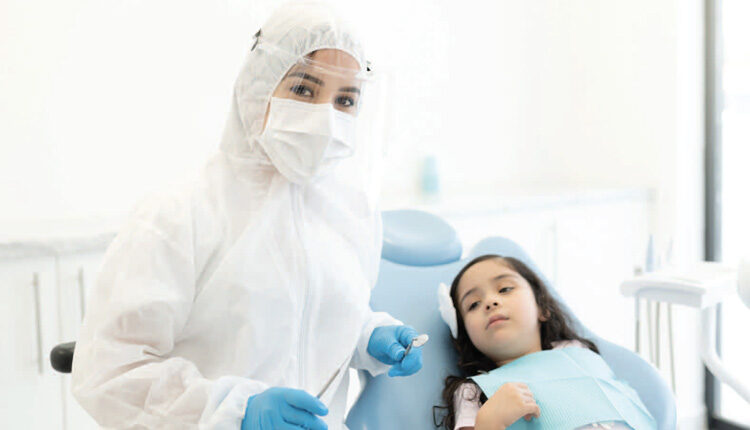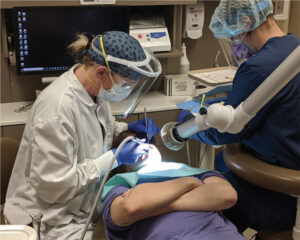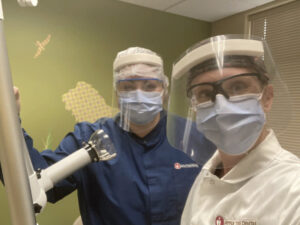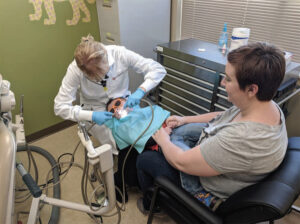 ANTONIO_DIAZ CREDIT/ISTOCK/GETTY IMAGES PLUS
ANTONIO_DIAZ CREDIT/ISTOCK/GETTY IMAGES PLUS
A Week in the Life of a Dual-Licensed Advanced Dental Therapist
Variety is the common denominator in the professional life of this clinician.

I was excited to receive an invitation from Perspectives on the Midlevel Practitioner to write about providing restorative care as a dental hygienist, especially when she said the readers would be dental hygienists interested in dental therapy. The perfect audience!
I feel lucky to live in Minnesota and to have graduated in the first class of dental therapy. I have been a dental hygienist since 2002 and a dental therapist since 2011. Prior to going into dental therapy, I worked as a private practice dental hygienist from 2002 to 2008 and, while I enjoyed it, after a few years, I felt like something was missing. This was when my former instructor and mentor, Colleen M. Brickle, EdD, RDH, dean of health sciences at Normandale Community College, encouraged me to try working in public health. I began working for Apple Tree Dental (ATD), a nonprofit organization with centers throughout Minnesota. ATD provides dental care to underserved populations including low-income families, adults with special needs, and older adults living in long-term care settings. Care is delivered at dental centers to more than 140 community sites including group homes, Head Starts, and long-term care settings through a mobile program.
Legislative Action
After I began at ATD as a collaborative practice dental hygienist, Brickle introduced me to legislation she was working on with then Minnesota Senator Ann Lynch (now the director of advocacy and education at the American Dental Hygienists’ Association) to develop an advanced dental hygiene practitioner. When the legislation passed (with wording changed in negotiations to “dental therapist”) in a remarkably quick two sessions, she also encouraged me to apply to be in the first class. While I really had little interest in restorative dentistry, I was passionate about expanding care to underserved populations. Luckily, transitioning to public health and pursuing the dental therapy degree wound up being two of my best career decisions!
I am fortunate to be able to use my full education and both of my licenses in my position. With two licenses, my scope of practice meets the majority of underserved patients’ oral healthcare needs.

Importance of Dual Licensure
I am fortunate to be able to use my full education and both of my licenses in my position. With two licenses, my scope of practice meets the majority of underserved patients’ oral healthcare needs. Each day of practice is different. Since the COVID-19 pandemic began, practice is decidedly different. ATD’s response to the pandemic and how we safely and carefully treat patients are exceptional. Two positive changes in this unprecedented time resulted: a greater use of silver diamine fluoride (SDF) and other minimally invasive treatment options and the expansion of teledentistry so the entire staff can work to the top of their license(s).
What follows is my average week as a dual licensed advanced dental therapist and dental hygienist to showcase how I provide care in different ways each day.
Restorative care
On Mondays and Tuesdays and every other Friday, I work at ATD’s Mounds View Center. It is a busy 16-operatory dental clinic full of dental hygienists, dental assistants, dentists, dental residents, dental specialists, and myself. I am currently the only ADT at our center, but as an organization, ATD employs 10 dental therapists. The majority of my day is providing restorative care at this site (Figure 1 and Figure 2).
A pediatric dental specialist works 3 days a week at this site. He provides intravenous sedation and care under general anesthesia on-site once a week. His schedule is always full with new referrals from general offices around the Twin Cities and the state.
We have developed a triage process. I see the children before they are scheduled with the dentist to assess behavior, provide a limited exam, and often place SDF for caries disease management and stabilization. If children are cooperative, I provide some or all of their treatment. In Minnesota, as a dual licensed practitioner, I can provide a full scope of preventive services to pediatric patients, such as exams, fabrication of space maintainers, and restorative care, which incudes restorations, extractions, and pulpotomies.

Teledentistry
Since the COVID-19 pandemic began, my supervising dentist, Ashley Johnson, DMD, and I helped develop a synchronous teledentistry program to provide live remote patient exams. Patients are triaged over the phone via photos they email to us or though a Health Insurance Portability and Accountability Act-compliant video chat using Microsoft Teams. When routine dental care shut down in March, we were able to identify true emergencies that required a trip into the clinic vs situations that could be managed at home. Triaging patients using teledentistry prior to a visit reduced the time a patient was in the office. While now back to providing routine care, we continue to use this modality when possible to eliminate unnecessary trips into the clinic and reduce the amount of time a patient is in the office.
When our dental hygienists returned to work in July, we focused on implementing workflow strategies for our hygiene exams to reduce the amount of personal protective equipment used and decrease transmission risk (Figure 3). The protocols involve using asynchronous teledentistry for hygiene exams on low-risk patients. The dental hygienist performs an assessment and takes intraoral camera images and radiographs as needed. This information is stored and forwarded to the dentist or advanced dental therapist to complete the exam. A treatment plan is then emailed to the patient, or a clinic care coordinator calls the patient. If our dental hygienists identify obvious treatment needs, they schedule the patient with a dentist or advanced dental therapist for their exam and treatment.
My clinic days often consist of those periodic exams referred from dental hygienists. I complete all types of restorations independent of size, location, patient demographics, or material. If I identify a procedure outside of my scope of practice, I reschedule the patient back with one of our dentists or dental specialists, or refer to an outside specialist if indicated.
Consider learning more about dental therapy so you can contact legislators and provide accurate information to other oral health professionals and the public about this new profession.

Mobile Dentistry
Wednesdays are my favorite day, as I provide care at one of our community sites using mobile dental equipment. Sites include a senior housing facility for veterans, a day center for adults with developmental disabilities, other group home service centers, and long-term care facilities. Currently, due to COVID-19, I am primarily providing care at a federally qualified health center pediatric clinic. Along with a dental assistant, children receive preventive and restorative care (Figure 4); often all care is completed in one visit. The goal of the partnership is for families to have both medical and dental needs met in one appointment. At my most recent clinic day, 11 children from three families received exams and preventive services. In addition, SDF, silver modified atraumatic restorative treatment restorations, and traditional restorations were placed.
Thursdays are my teledentistry days when I provide synchronous (live video) problem-focused exams as well as complete the asynchronous teledentistry periodic exams for our dental hygienists. On these days, patients who require multiple appointments or quadrant dentistry are treated in order to provide care in a timely manner.
Take Action
I am passionate about my work due to the variety of procedures and treatment methodologies utilized and the different settings in which care is provided. If you are a dental hygienist with interest outside of the traditional private practice setting, consider this career option. If you enjoy traditional private practice but are interested in furthering your education in research, education, or further clinical practice, I hope you pursue that goal. There are many exciting alternative career paths and advanced educational opportunities for dental hygienists to pursue that build on our foundational education.
If your state is pursuing dental therapy legislation, I encourage you to get involved. Consider learning more about dental therapy so you can contact legislators and provide accurate information to other oral health professionals and the public about this new profession.
Whether you pursue these paths or not, it is important to support them, not only for your colleagues who want to pursue these opportunities, but for the betterment of our profession.

Adapted from the American Dental Hygienists’ Association. Expanding Access to Care Through Dental Therapy. Available at: adha.org/resources-docs/Expanding_Access_to_Dental_Therapy.pdf. Accessed November 10, 2020.
From Perspectives on the Midlevel Practitioner, a supplement to Dimensions of Dental Hygiene. November 2020(12):11-15.

